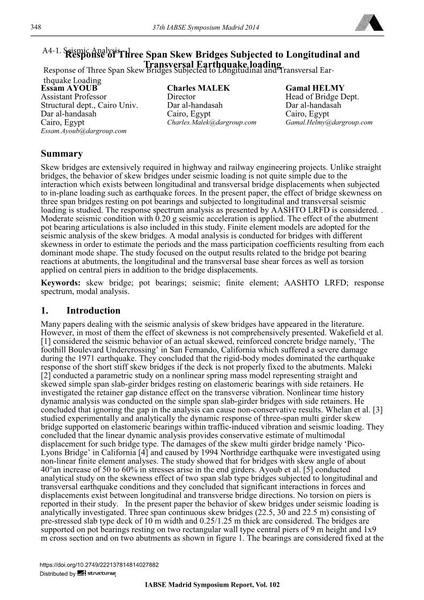Transversal Earthquake loading

|
|
|||||||||||
Bibliografische Angaben
| Autor(en): |
Essam Ayoub
Charles Malek Gamal Helmy |
||||
|---|---|---|---|---|---|
| Medium: | Tagungsbeitrag | ||||
| Sprache(n): | Englisch | ||||
| Tagung: | IABSE Symposium: Engineering for Progress, Nature and People, Madrid, Spain, 3-5 September 2014 | ||||
| Veröffentlicht in: | IABSE Symposium Madrid 2014 | ||||
|
|||||
| Seite(n): | 348-355 | ||||
| Anzahl der Seiten (im PDF): | 8 | ||||
| Jahr: | 2014 | ||||
| DOI: | 10.2749/222137814814027882 | ||||
| Abstrakt: |
Skew bridges are extensively required in highway and railway engineering projects. Unlike straight bridges, the behavior of skew bridges under seismic loading is not quite simple due to the interaction which exists between longitudinal and transversal bridge displacements when subjected to in-plane loading such as earthquake forces. In the present paper, the effect of bridge skewness on three span bridges resting on pot bearings and subjected to longitudinal and transversal seismic loading is studied. The response spectrum analysis as presented by AASHTO LRFD is considered. . Moderate seismic condition with 0.20 g seismic acceleration is applied. The effect of the abutment pot bearing articulations is also included in this study. Finite element models are adopted for the seismic analysis of the skew bridges. A modal analysis is conducted for bridges with different skewness in order to estimate the periods and the mass participation coefficients resulting from each dominant mode shape. The study focused on the output results related to the bridge pot bearing reactions at abutments, the longitudinal and the transversal base shear forces as well as torsion applied on central piers in addition to the bridge displacements. |
||||
| Stichwörter: |
Modalanalyse finites Element Antwortspektrum Topflager
|
||||
